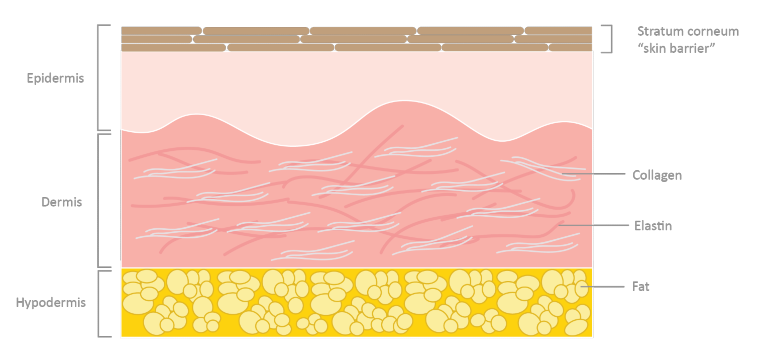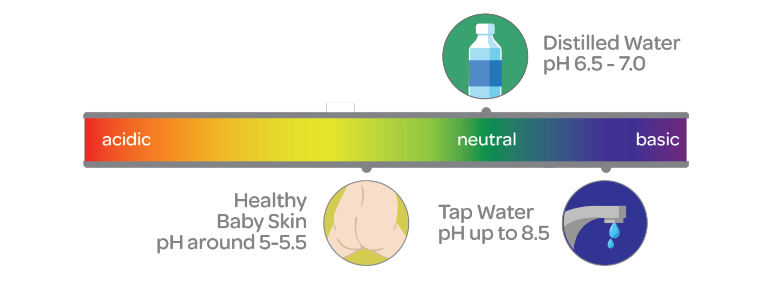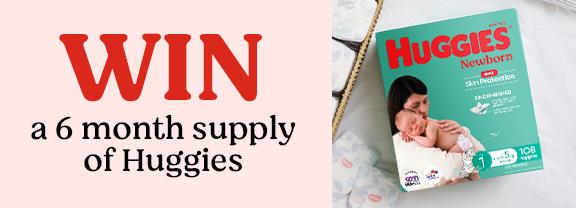Learn about the characteristics of healthy baby skin so you can be better prepared to help keep your baby’s skin clean and healthy.
Importance of Healthy Baby Skin:
Baby’s skin is the primary defense against the outside world, providing protection from physical, chemical, and biological dangers. It also helps regulate babies’ body temperature and contains nerve cells that allow babies to experience touch. At birth, healthy infants have delicate skin which can be up to 30% thinner than adult skin, making them more susceptible to irritation. Infants born prematurely have even more fragile skin at birth, which increases their risk for skin damage and irritation. Skin will continue to develop throughout the first year of life, making it incredibly important to provide gentle care and protection to ensure baby’s skin stays healthy.
Baby skin is made up of three main layers:
Epidermis:
- Contains the Stratum corneum or skin barrier - outermost sublayer of the epidermis that protects baby from the external environment and only layer that we can see
Dermis:
- The middle layer of skin which provides strength and elasticity
Hypodermis:
- The innermost skin layer which stores fat and provides insulation and shock absorption
- This layer attaches the top two layers of skin (epidermis and dermis) to cartilage and bone

Characteristics of healthy baby skin include:

- An intact skin barrier, free of redness and dryness/scaling:
- Helps prevent penetration of irritants and harmful microorganisms
- Effectively retains moisture inside the body to help prevent dehydration
- Characterized by a diverse, healthy microbiome
- A healthy, intact skin barrier is essential for overall health
- Several factors can contribute to skin barrier damage such as: changes in skin pH, irritants (like those found in urine and poop), abrasion, excess moisture on skin
- Slightly acidic skin surface pH:
- Healthy infant skin has a pH around 5-5.5 which is important for:
- Proper structure and function of the skin barrier to help keep skin moisturized and healthy
- Preventing the overgrowth of harmful bacteria on the skin surface that can lead to skin barrier damage
- Excess moisture on skin and irritants from urine and poop can cause an increase in skin pH and the potential for irritation. What is Nappy Rash?
- Healthy infant skin has a pH around 5-5.5 which is important for:
- Balanced skin moisture:
- Infant skin absorbs moisture faster than adult skin, but it also loses moisture faster
- Ensuring that the skin is well moisturized is important for health:
- Excess loss of moisture can lead to skin dryness
- Excess moisture in the diapered area for a prolonged period of time can cause damage to the skin barrier, making it more permeable to irritants and microorganisms.
Infant skin has unique needs; gentle care is essential to prevent damage to the skin barrier, which can lead to irritation. When caring for infant skin, especially in the diapered area, it is important to understand all the factors that contribute to skin irritation and lead to a rash. This means being selective about the products that you use is essential for caring for your baby’s skin. Using baby wipes formulated with a slightly acidic pH to complement baby’s skin pH helps keep the skin clean and healthy. Frequent diaper changes and the use of breathable, absorbent diapers that can quickly wick away excess moisture from your baby’s bottom can also help preserve the skin barrier integrity.
Debbie Ngai, BS Chemical Engineering
Reviewed by: Karien Rodriguez, PhD Biomedical Engineering
References
- Stamatas GN, Nikolovski J, Luedtke MA, Kollias N, Wiegand BC. Infant skin microstructure assessed in vivo differs from adult skin in organization and at the cellular level. Pediatr Dermatol. 2010 Mar-Apr;27(2):125-31. doi: 10.1111/j.1525-1470.2009.00973.x. Epub 2009 Oct 4. PMID: 19804498..
- Oranges T, Dini V, Romanelli M. Skin Physiology of the Neonate and Infant: Clinical Implications. Adv Wound Care (New Rochelle). 2015 Oct 1;4(10):587-595. doi: 10.1089/wound.2015.0642. PMID: 26487977; PMCID: PMC4593874.
- Nikolovski J, Stamatas GN, Kollias N, Wiegand BC. Barrier function and water-holding and transport properties of infant stratum corneum are different from adult and continue to develop through the first year of life. J Invest Dermatol. 2008 Jul;128(7):1728-36. doi: 10.1038/sj.jid.5701239. Epub 2008 Jan 17. PMID: 18200056.
- Kolarsick PAJ, Kolarsick MA, Goodwin C. Anatomy and Physiology of the Skin. Journal of the Dermatology Nurses' Association. 2011 Jul(3:4):203-213. doi: 10.1097/JDN.0b013e3182274a98
- Schmid-Wendtner MH, Korting HC. The pH of the skin surface and its impact on the barrier function. Skin Pharmacol Physiol. 2006;19(6):296-302. doi: 10.1159/000094670. Epub 2006 Jul 19. PMID: 1686497
Last Published* May, 2024
*Please note that the published date may not be the same as the date that the content was created and that information above may have changed since.















